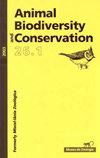重组酶聚合酶扩增结合快速DNA提取技术现场鉴定濒危物种急尖脱蝮蛇
IF 1
4区 环境科学与生态学
Q3 BIODIVERSITY CONSERVATION
引用次数: 0
摘要
摘要本研究利用重组酶聚合酶扩增结合快速DNA提取技术,对因过度开发和栖息地破坏而受到威胁的蛇类——尖锐Deinagkistrodon acutus进行现场鉴定。为了保护大熊猫,迫切需要一种有效的物种鉴定方法来打击非法捕捞和贸易。在中国南方山区共采集到12种蛇类14只,包括尖尾蛇和其他蛇类。基因组DNA在5分钟内通过改良的碱法提取。根据细胞色素C氧化酶亚基I (COI)条形码区序列设计了重组酶聚合酶扩增(RPA)的种特异性引物,并建立了优化的RPA检测体系。验证了该方法的特异性和敏感性,并对10个市售芪蛇药材样品进行了验证。在优化后的RPA条件下,只扩增出了尖锐尖刺蛇的条带,而没有扩增出近缘种蛇的条带,条带长度为354bp。整个过程可在室温下30分钟内完成。市售芪蛇药材鉴定验证了所建立的分析体系的有效性。采用快速提取DNA的重组酶聚合酶扩增(RPA)技术,建立了一种特异性和敏感性良好的现场鉴定方法。该方法可为加强对针鼹非法捕获和交易的严格监管提供有效工具。本文章由计算机程序翻译,如有差异,请以英文原文为准。
Recombinase polymerase amplification combined with fast DNA extraction for on–spot identification of Deinagkistrodon acutus, a threatened species
This study addresses the use of recombinase polymerase amplification combined with fast DNA extraction for on–spot identification of Deinagkistrodon acutus, a snake species threatened
due to over–exploitation and habitat destruction. For its conservation, an efficient species identification method is urgently neededto fight against illegal capture and trade. Fourteen individuals representing 12 snake species (including D. acutus and other snake species) were collected from mountainous regions in Southern China. Genomic DNA was extracted within five minutes by a modified alkaline lysis method. Species–specific primers for recombinase polymerase amplification (RPA) were designed based on the sequences of cytochrome C oxidase subunit I (COI) barcode region, and an optimized RPA assay system was set up. Specificity and sensitivity of the assay were checked, and the assay was validated by identifying 10 commercial Qi She crude drug samples derived from D. acutus. Under optimized RPA conditions, a distinct single band of 354 bp was amplified only for D. acutus but not for the related snake species. The entire procedure can be completed in 30 min at room temperature. Commercial Qi She crude drug identification validated effectiveness of the established assay system. Using a recombinase polymerase amplification (RPA) assay with rapid DNA extraction, we established an on–spot D. acutus identification method with good specificity and sensitivity. This method could become an efficient tool for rigorous supervision of illegal D. acutus capture and trade.
求助全文
通过发布文献求助,成功后即可免费获取论文全文。
去求助
来源期刊

Animal Biodiversity and Conservation
农林科学-动物学
CiteScore
2.00
自引率
0.00%
发文量
21
审稿时长
>12 weeks
期刊介绍:
Animal Biodiversity and Conservation (antes Miscel·lània Zoològica) es una revista interdisciplinar, publicada desde 1958 por el Museu de Ciències Naturals de Barcelona. Incluye artículos de investigación empírica y teórica en todas las áreas de la zoología (sistemática, taxonomía, morfología, biogeografía, ecología, etología, fisiología y genética) procedentes de todas las regiones del mundo. La revista presta especial interés a los estudios que planteen un problema nuevo o introduzcan un tema nuevo, con hipòtesis y prediccions claras, y a los trabajos que de una manera u otra tengan relevancia en la biología de la conservación. No se publicaran artículos puramente descriptivos, o artículos faunísticos o corológicos en los que se describa la distribución en el espacio o en el tiempo de los organismes zoológicos.
 求助内容:
求助内容: 应助结果提醒方式:
应助结果提醒方式:


